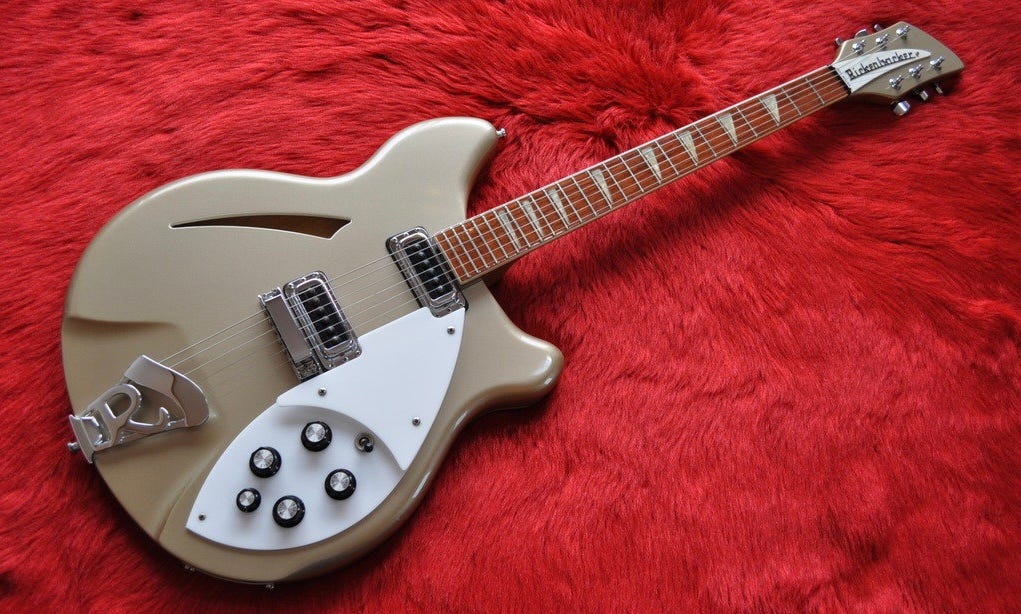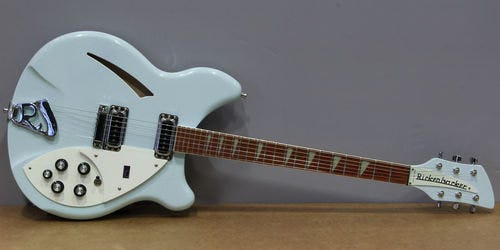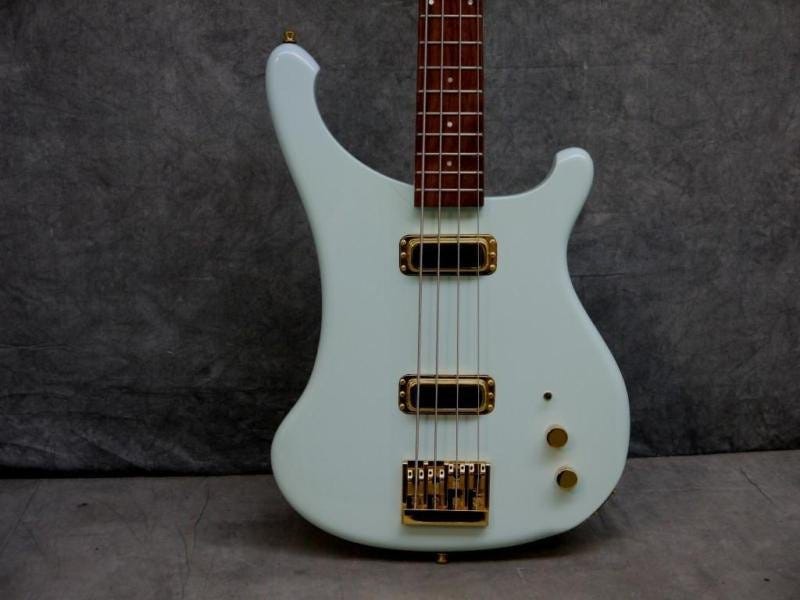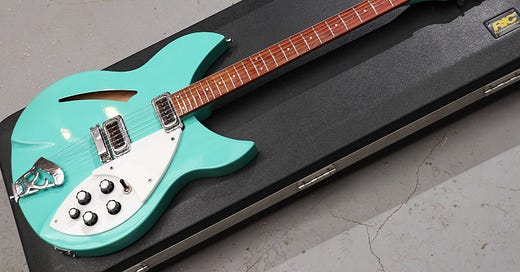I have a theory that goes like this: there is a finite demand for “stock” Rickenbacker guitars that is slightly less than the factory’s capacity. “But the backlog!” you protest. Yes, there is a backlog…kinda. Rickenbacker produces in factory-efficient batches, and some guitars only get one or two batches per year. Or even less often! That’s what the finite demand for that guitar dictates. So unless the guitar you want just came off its run, you’re probably going to have to wait until the next batch—which could be a long way away. But…there’s always SOMETHING available in the market. Not all guitars are presold before they hit the dealer’s shelf. Now, it may not be the model or the color you want right then, but there’s always something available. If they were running at 100% capacity full time and that wasn’t enough to satisfy the market…there’d never be anything on the shelves. And there just is.
But I just said their capacity is higher than the demand, right? Does that mean I think they are artificially throttling supply to make demand look higher than it is? No, I don’t think that’s true. I think the difficulty in finding the guitar you want RIGHT NOW is the product of their batch-based manufacturing process and the fact that they “reserve” some of their capacity for “special stuff”. What that “special stuff” is has varied over time during the John Hall years. Right now, and for the past 10-15 years or so, the “special stuff” has been special dealer runs. Click HERE to read about the 63 (!) special dealer runs we’ve identified from 2016-today for an example of what I’m talking about, or HERE to read about earlier examples. From the late 80s to the late 90s it was the Limited Signature Edition models you can read about HERE. And in the early 2000’s, the “special stuff” was the Color of the Year.
So what exactly was “Color of the Year”? Well, it’s pretty much exactly what it sounds like. Each year between 2000 and 2006 Rickenbacker would offer a special color that could be ordered on ANY guitar in the line. Well, within limits. You couldn’t order most “Beatle” guitars (the 325C58, 325C64, 325V59, 325V63, 360/12C64, and 360/12V64) in the Color of the Year (which we will refer to from this point on as COY), but anything else was fair game. The order book opened up on January 1st, and they stopped taking orders on December 31st. Which means, obviously, that not every COY guitar was made in “its year”. For some lower volume guitars, production dates could be as long as two years after the order year—a function of when the next production batch occurred. So let’s get into it!
2000 Sea Green

The debut Color of the Year was Sea Green—one of the most striking and unusual of the colors. It’s a little darker and bluer than Fender Surf Green, and a little greener than Fender Seafoam Green, although photographs can vary wildly based on the lighting and the clearcoat can amber, boosting the green.
As the first year of the series, Sea Green is one of the rarer colors today and that rarity brings desirability. Clean examples today on “core” guitars (330, 360, 4003, 620) carry a $1K-$1.5K premium over their standard color counterparts. For lower volume guitars add another $500 to that range. But there aren’t many of the latter out there—as the first year, most folks hadn’t gotten the word or gotten “creative” yet in their orders. That would happen in the years to come!

2001 Desert Gold

Not gonna lie. Desert Gold was a bit of a letdown after Sea Green. Lighter than a Gibson goldtop, it doesn’t really stand out or “pop”. Despite being one of the rarer colors today, it’s also one of the least valuable colors. Clean examples on “core” guitars carry a $500-$1K premium over their standard color counterparts. For lower volume guitars add another $500 to that range—but again, there aren’t that many of those out there.

2002 Burgundy

Burgundy was an somewhat unusual choice for 2002 given that it wasn’t a “new” color—Burgundy had been a stock color from 1967-1984 (although earlier and later custom orders exist) and had recently appeared on the 1999 425V63 and 450V63. That said, it’s a very popular color among collectors, so it’s not a crazy choice. It is a little strange to see Burgundy on a guitar with the 2002-correct paddle headstock, though. Clean examples on “core” guitars carry a $500-$1K premium over their standard color counterparts. For lower volume guitars add another $500 to that range—but once again, there aren’t that many of those out there.

2003 Montezuma Brown

Montezuma Brown was a color that carried some history with it—although this version had nothing in common with the first “Montezuma Brown” Rickenbackers. That version was a solid reddish brown that appeared on 1954-1957 Combo 400 and 450s. This version was a dark brown to natural burst that was much closer to the “Shaded Brown” found on first year Capris.
Montezuma Brown proved to be popular enough that there have been a number of special runs since. Clean examples on “core” guitars carry a $500-$1K premium over their standard color counterparts. For lower volume guitars add another $500 to that range. Montezuma Brown was the first color where we started to see larger numbers of “non core” guitars ordered as people started to think about future collectibility.

2004 Blue Boy

Blue Boy was another nod to Rickenbacker’s past: they had produced three guitars in 1961 for the Jim Reeves Band in a custom light blue they named “Blue Boy” in honor of his hit record…“Blue Boy”. The color reappeared in 2001 and 2002 special runs for Japan and the UK, and then was introduced as the 2004 Color of the Year.
Unfortunately, these tend to yellow unevenly. Meaning clean ones are fairly difficult to find. A strong contender for the title of “the most popular color” from the COY era today, clean examples on “core” guitars carry a $1K-$1.5K premium over their standard color counterparts. For lower volume guitars add up to another $1K to that range—but you have a lot more choices here than earlier colors. If Montezuma Brown got people thinking about future collectability, Blue Boy shifted that into overdrive and you find the finish on all kinds of odd models—like the 4004 below. There was another special run of Blue Boys for Japan in 2014, but those were a little bit lighter and greener.

2005 Blueburst

Blueburst is the other contender for most popular COY color. It’s…exactly what it sounds like. A blue sunburst. It appears to be the same base color as the Trans Blue that first appeared on the 4004 in 2000…only applied in a burst pattern.
In my opinion, this color looks fantastic on Deluxe guitars—it makes the contrasting white binding really pop, it looks AMAZING on guitars like the 660 and 381 with flamey wood, and it looks “meh” on everything else. Prices reflect that, with clean Standard guitars carrying a $500-$1K premium over their standard color counterparts, Deluxe guitars carrying a $1K-$1.5K premium, and guitars like the 660 and 381 adding up to another $1K to that range. And there’s plenty of 660 and 381s out there, as folks seem to have realized just how great this color would work on those models. This finish can “grey” or “purple” from UV exposure over time.

2006 Amber Fireglo

Over time and with UV exposure, the older Rickenbacker conversion varnish finish yellows. This process gives older guitars a warm, amber finish that is prized by many. The 2006 Color of the Year attempted to reproduce that effect by adding a yellow tint to the clearcoat, thus the name: Amber Fireglo. And it succeeds…to a point. It’s pretty obvious what they did when you look at the binding and the fretboard—particularly the inlays. That kind of spoils the effect to me.
But it was popular enough that they used it again several times on special runs over the next decade. And while they reprised the name and color for the 4005XC, they changed the process by applying the amber colorant “below” the clearcoat, leaving the binding and inlays nice and bright. Today, clean examples on “core” guitars carry a $500-$1K premium over their standard color counterparts. For lower volume guitars add another $500 to that range.

2006 was the last year for Color of the Year. Why did it end? Not 100% sure. My best guess is that demand had grown to the point where it was no longer sustainable. It took them until early 2009 to finish all the 2006 Amber Fireglo orders—and there were even a handful of Bluebursts (mostly 5002s) in 2009 as well. Whatever the reason, that “extra capacity” found a new home shortly with the rise of the “special run” era we still live in today. What comes next? I vote custom shop!




Great job, very interesting article!
I think Turquoise was a COY as well, and is my favorite of the factory green/blue shades.
I always wanted a turquoise 4004 I saw online, but never managed to nab it. (Allegedly only 2 made, but I’ve never seen a second example anywhere, so maybe just the one?)
I did own a BBR Cheyenne ii, that was absolutely gorgeous. Oh, and the one or 2 examples of AFG Ciis were BEAUTIFUL .
I agree the AFG 4003 you posted is over the top….